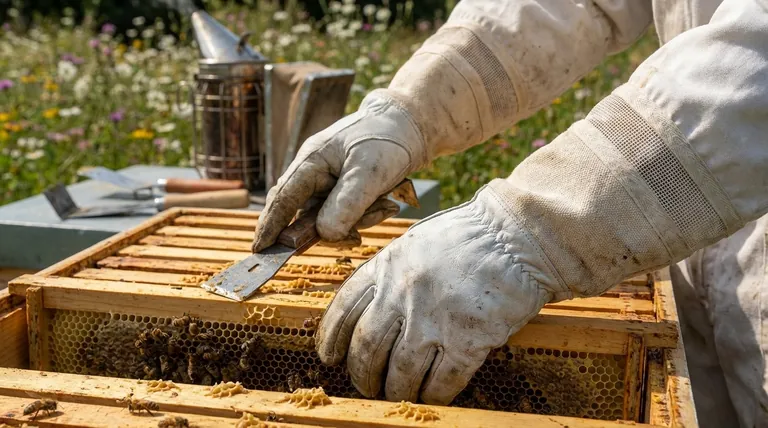Choosing the right beekeeping gloves is a critical decision that balances personal safety with the delicate task of hive management. The most important factors are ensuring a snug fit for maximum dexterity and safety, and selecting a material that provides the appropriate level of sting protection for your experience and comfort level.
The central challenge in selecting beekeeping gloves is navigating the trade-off between protection and dexterity. Your goal is to find a glove that makes you feel safe without preventing you from being a gentle and effective beekeeper.

The Foundational Elements of a Good Glove
The effectiveness of any beekeeping glove comes down to two fundamental characteristics: how it fits your hand and the material it's made from. Getting these right is essential for both your safety and the well-being of your bees.
Why Fit is Non-Negotiable
A proper, snug fit is the single most important factor. Gloves that are too loose or have excess material at the fingertips create significant problems.
Poorly-fitting gloves increase the risk of accidentally crushing bees, which can trigger a defensive response from the colony.
They also reduce your dexterity, making it difficult to handle delicate hive components like frames or the queen. A snug fit ensures you can move with precision and confidence.
Preventing Unwanted Entry
A key function of a well-fitting glove is to create a secure seal around your wrist. This prevents curious bees from crawling inside, which is a common cause of stings on the wrists and forearms.
Matching the Glove to Your Needs
Different beekeepers have different priorities. Your experience level, sensitivity to stings, and the specific tasks you're performing will determine the best choice for you.
For Beginners and the Cautious
Most beginners should start with thicker, sting-proof gloves, often made of leather. This provides maximum protection and helps build confidence while learning to read bee behavior.
If you have a known allergy to bee venom, thick and durable gloves are not optional—they are an essential piece of safety equipment.
For Experienced Beekeepers and Delicate Tasks
As you gain experience, you may prioritize dexterity over maximum protection. Some beekeepers opt for thinner gloves to better feel the hive components.
For quick tasks or as a low-cost entry point, cheaper disposable gloves can be used. However, they offer minimal sting protection and are not suitable for all situations.
Understanding the Trade-offs
Choosing a beekeeping glove is not about finding a single "best" option, but about understanding the compromises inherent in each design.
Protection vs. Dexterity
This is the core trade-off. Thick leather gloves offer excellent sting protection but make it difficult to feel what you're doing. You can't easily handle a queen or inspect delicate brood cells.
Thinner gloves provide a much better feel for the hive but offer significantly less protection from stings. The choice depends entirely on your personal comfort with this risk.
The Hidden Dangers of a Poor Fit
Beyond just being clumsy, a poor fit is a direct risk. Excess material can easily snag on frames or other hive parts, causing you to make sudden, jerky movements that will alarm the bees.
This clumsiness not only agitates the colony but also increases the likelihood of you dropping equipment or damaging the delicate wax comb.
Making the Right Choice for Your Goal
Select your gloves based on a clear understanding of your priorities as a beekeeper.
- If your primary focus is maximum safety and confidence as a beginner: Choose thick, sting-proof leather gloves with long, secure cuffs.
- If your primary focus is dexterity for delicate hive work: Opt for a more form-fitting glove, accepting that it may offer less sting protection.
- If your primary focus is managing costs for infrequent inspections: Inexpensive disposable gloves can work, but understand their limitations in protection.
Ultimately, the best glove is the one that allows you to work calmly, confidently, and safely with your bees.
Summary Table:
| Factor | Key Consideration | Why It Matters |
|---|---|---|
| Fit | Snug, with no excess material | Prevents crushing bees, improves dexterity, stops bees from entering |
| Material | Leather (thick/thin), Disposable | Determines level of sting protection vs. tactile feel |
| Experience Level | Beginner vs. Experienced | Influences the need for maximum protection vs. high dexterity |
| Primary Goal | Safety, Dexterity, or Cost | Helps prioritize the most important feature for your beekeeping style |
Ready to equip your apiary with the right gear?
Choosing the correct gloves is just the start. HONESTBEE supplies durable, well-designed beekeeping gloves and a full range of equipment to commercial apiaries and distributors. Our wholesale-focused operations ensure you get the reliable, high-performance supplies you need to work safely and efficiently.
Contact HONESTBEE today to discuss your beekeeping supply needs and request a wholesale catalog!
Visual Guide

Related Products
- Goatskin Leather Beekeeper Gloves with Vent Long Sleeve for Beekeeping Honey Bee Sting Proof Protection
- Mesh Ventilated 3 Layer Goatskin Beekeepers Gloves for Beekeeping
- Goat Skin Leather Bee Sting Proof Beekeeping Gloves with Canvas Sleeve
- Professional Galvanized Hive Strap with Secure Locking Buckle for Beekeeping
- Wooden Queen Bee Excluder for Beekeeping
People Also Ask
- How can you wash beekeeping gloves? A Guide to Preserving Your Gear & Hive Health
- How do beekeeping gloves help in maintaining hygiene? Essential for Hive Biosecurity
- Why is it important to have gloves available even if not always worn? Essential Risk Management for Beekeepers
- What is the importance of choosing the right gloves for beekeeping? Balance Protection and Dexterity for Hive Success
- What are the characteristics of beekeeping gloves? Balancing Sting Protection with Dexterity



















